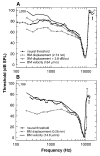Frequency tuning of basilar membrane and auditory nerve fibers in the same cochleae
- PMID: 9836636
- PMCID: PMC3578392
- DOI: 10.1126/science.282.5395.1882
Frequency tuning of basilar membrane and auditory nerve fibers in the same cochleae
Abstract
Responses to tones of a basilar membrane site and of auditory nerve fibers innervating neighboring inner hair cells were recorded in the same cochleae in chinchillas. At near-threshold stimulus levels, the frequency tuning of auditory nerve fibers closely paralleled that of basilar membrane displacement modified by high-pass filtering, indicating that only relatively minor signal transformations intervene between mechanical vibration and auditory nerve excitation. This finding establishes that cochlear frequency selectivity in chinchillas (and probably in mammals in general) is fully expressed in the vibrations of the basilar membrane and renders unnecessary additional ("second") filters, such as those present in the hair cells of the cochleae of reptiles.
Figures

Similar articles
-
Low-frequency suppression of auditory nerve responses to characteristic frequency tones.Hear Res. 1997 Nov;113(1-2):29-56. doi: 10.1016/s0378-5955(97)00129-9. Hear Res. 1997. PMID: 9387984 Free PMC article.
-
Auditory peripheral tuning: evidence for a simple resonance phenomenon in the lizard Tiliqua.Hear Res. 1988 May;33(2):181-9. doi: 10.1016/0378-5955(88)90031-7. Hear Res. 1988. PMID: 3397328
-
Threshold tuning curves of chinchilla auditory nerve fibers. II. Dependence on spontaneous activity and relation to cochlear nonlinearity.J Neurophysiol. 2008 Nov;100(5):2899-906. doi: 10.1152/jn.90639.2008. Epub 2008 Aug 27. J Neurophysiol. 2008. PMID: 18753325 Free PMC article.
-
Basilar membrane motion in relation to two-tone suppression.Hear Res. 1998 Jan;115(1-2):129-42. doi: 10.1016/s0378-5955(97)00187-1. Hear Res. 1998. PMID: 9472742 Review.
-
The role of outer hair cells in cochlear function.Prog Clin Biol Res. 1985;176:207-30. Prog Clin Biol Res. 1985. PMID: 3889930 Review. No abstract available.
Cited by
-
How are inner hair cells stimulated? Evidence for multiple mechanical drives.Hear Res. 2012 Oct;292(1-2):35-50. doi: 10.1016/j.heares.2012.08.005. Epub 2012 Aug 24. Hear Res. 2012. PMID: 22959529 Free PMC article.
-
Mechanics of the mammalian cochlea.Physiol Rev. 2001 Jul;81(3):1305-52. doi: 10.1152/physrev.2001.81.3.1305. Physiol Rev. 2001. PMID: 11427697 Free PMC article. Review.
-
Hair Cell Transduction, Tuning, and Synaptic Transmission in the Mammalian Cochlea.Compr Physiol. 2017 Sep 12;7(4):1197-1227. doi: 10.1002/cphy.c160049. Compr Physiol. 2017. PMID: 28915323 Free PMC article. Review.
-
Tonotopic Selectivity in Cats and Humans: Electrophysiology and Psychophysics.J Assoc Res Otolaryngol. 2022 Aug;23(4):513-534. doi: 10.1007/s10162-022-00851-5. Epub 2022 Jun 13. J Assoc Res Otolaryngol. 2022. PMID: 35697952 Free PMC article.
-
Why do I hear but not understand? Stochastic undersampling as a model of degraded neural encoding of speech.Front Neurosci. 2014 Oct 30;8:348. doi: 10.3389/fnins.2014.00348. eCollection 2014. Front Neurosci. 2014. PMID: 25400543 Free PMC article. Review.
References
-
- Spoendlin H. Arch. Klin. Exp. Ohr. Nas Kehlk. Heilk. 1971;200:275. - PubMed
-
- Russell IJ, Richardson GP, Cody AR. Nature. 1986;321:517. - PubMed
-
- Ruggero MA. In: Active Hearing. Flock Å, Ottoson D, Ulfendahl M, editors. Pergamon/Elsevier; Oxford, UK: 1995. pp. 321–336.
-
- Sellick PM, Patuzzi R, Johnstone BM. J. Acoust. Soc. Am. 1982;72:131. - PubMed
Publication types
MeSH terms
Grants and funding
LinkOut - more resources
Full Text Sources

